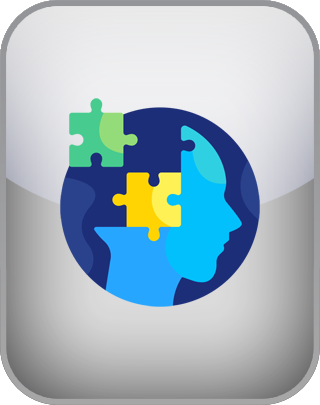Autism Spectrum Quotient (AQ) Test
The Autism Spectrum Quotient (AQ) Test, developed by Professor Simon Baron-Cohen and colleagues at the University of Cambridge, measures traits associated with the autism spectrum. Designed for adults, this test helps assess how closely an individual aligns with common characteristics of autism. While not a diagnostic tool, it offers valuable insights into social, communication, and behavioral tendencies. For accurate interpretation, results should be reviewed alongside professional guidance.
Question 1 of 50
When I’m reading a story, I can easily imagine what the characters might look like.
NEXT
The Autism Spectrum Quotient (AQ) Test is a self-assessment tool designed to measure the extent to which an individual exhibits traits associated with autism spectrum disorder (ASD). Developed by Simon Baron-Cohen and his colleagues at the Autism Research Centre at the University of Cambridge in 2001, the AQ Test aims to identify autism-related characteristics in adults, primarily those with average or above-average intelligence. It is widely used in both research and clinical settings as a screening tool, although it is not intended to provide a definitive diagnosis.
Structure of the AQ Test
The AQ Test consists of 50 questions that cover five distinct areas often affected in individuals on the autism spectrum:
Social Skill: Assessing comfort and ease in social situations.
Attention Switching: Measuring flexibility in shifting focus and adapting to new situations.
Attention to Detail: Evaluating a tendency toward noticing and focusing on details.
Communication: Examining how one processes and expresses verbal and non-verbal information.
Imagination: Exploring creativity and the ability to think abstractly.
Each question has four possible responses: "definitely agree," "slightly agree," "slightly disagree," and "definitely disagree." Responses are scored 1 point if they align with autism traits, creating a total score between 0 and 50.
Purpose and Use
The AQ Test serves several purposes. It is used in research to study autism traits across populations and in clinical settings as a preliminary screening tool. A higher score may indicate the need for further evaluation, especially when the individual reports significant challenges in their daily life. However, it is essential to emphasize that the test is not a diagnostic instrument. Only a licensed professional, such as a psychologist or psychiatrist, can provide a formal diagnosis through comprehensive assessment.
Interpreting the Results
Results of the AQ Test are typically divided into tiers to reflect varying levels of autism traits:
Individuals scoring in the lower range exhibit few traits and are considered neurotypical.
Those scoring in the middle range may show some traits but might not meet the criteria for ASD.
Higher scores often suggest a likelihood of autism and warrant further investigation.
While the test is informative, it should not be viewed in isolation. Factors like anxiety, ADHD, or sensory processing issues can also influence scores, and a high or low score does not necessarily confirm or rule out autism.
Strengths and Limitations
One of the AQ Test's key strengths is its ability to provide quick insight into autism-related traits in adults. It is straightforward, widely accessible, and easy to administer. Additionally, its design makes it a valuable tool for raising awareness about ASD and helping individuals identify whether they might benefit from further assessment.
However, the test also has limitations. It relies on self-reported answers, which can be influenced by an individual's self-awareness or interpretation of the questions. Moreover, while it identifies traits, it does not account for the context or intensity of these traits in daily life.
The Autism Spectrum Quotient (AQ) Test is a useful screening tool that provides insight into autism-related traits. By highlighting specific areas where individuals may experience differences, it opens the door to further exploration and support. Although it is not diagnostic, it can serve as a helpful starting point for individuals seeking to better understand themselves or pursue a formal evaluation.
As the publishers of this free test, which allows you to screen yourself for autism-related traits, we strived to make the test as reliable and valid as possible by subjecting this test to statistical controls and validation. However, free online quizzes such as the present test do not provide professional assessments or recommendations of any kind; the test is provided entirely “as-is.” For more information about any of our online tests and quizzes, please consult our Terms of Service.

 English
English  Español
Español  Português
Português  Deutsch
Deutsch  Français
Français  Italiano
Italiano  Dansk
Dansk  Polski
Polski  Русский
Русский  Türkçe
Türkçe  日本語
日本語  한국어
한국어  汉语
汉语  Bahasa
Bahasa 